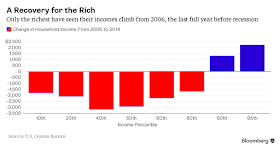“Trickle-down theory - the less than elegant metaphor that if one feeds the horse enough oats, some will pass through to the road for the sparrows.”
John Kenneth Galbraith
As I said earlier today in a reaction to the FOMC announcement:
"This is all a bit moot really, because except for the betting parlors it doesn't matter whether the Fed raises 25 basis points or not. You can print money and give it to the banking system and the very wealthy for their personal gambling and asset acquisitions activities all day long.
The system is broken, the real product of the nation has been hijacked by financialization, the international monetary exchange is in chaos, and almost all of the gains are going to the top.
And the Fed and the government are doing virtually nothing to change this."
The Banks must be restrained, and the financial system reformed, with balance restored to the economy, before there can be an sustainable recovery.
And keep the financial system on life support while the rest of the economy languishes, the poor suffer, and the middle class deteriorates is not coherent, except for a narrow band of beneficiaries.
Let us be reminded that the Fed is also a primary regulator of the financial system as well as an interest rate joystick operator.
And the mainstream media and the politicians wonder why the public is not doing what they expect.
This chart below is from Bloomberg News, The Richest Americans Are Winning the Economic Recovery.
"U.S. Census Bureau data out Wednesday underscore just how lousy the recovery has been if you aren't rich.
Looking at eight groups of household income selected by Census, only those whose incomes are already high to begin with have seen improvement since 2006, the last full year of expansion before the recession. Households at the 95th and 90th percentiles had larger earnings through 2014, the latest year for which data are available.
Income for all others was below 2006 levels, indicating they're still clawing their way out of the hole caused by the deepest recession in the post-World War II era."
And this result, after eight years of some of the biggest expansion of a central bank balance sheet in US history!

